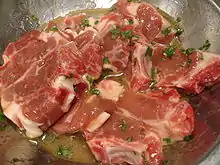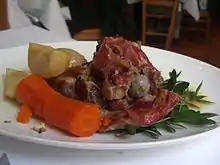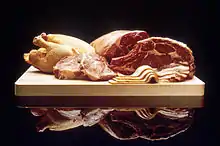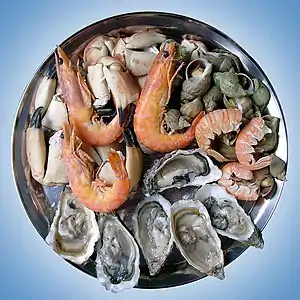Goat meat
Goat meat or goat's meat is the meat of the domestic goat (Capra aegagrus hircus). The common name for goat meat is simply "goat", though meat from adult goats is referred to as chevon, while that from young goats can be called capretto (It.), cabrito (Sp.) or kid. In South Asian and Caribbean cuisine, mutton commonly means goat meat.[1][2][3][4][5] In South Asia, where mutton curry is popular, "mutton" is used for both goat and lamb meat. The United States Department of Agriculture promoted the term "chevon", a portmanteau of chèvre ('goat') and mouton ('sheep', 'mutton') in the 1920s.[6][7]:19 According to market research, consumers in the United States prefer the pseudo-French-language-derived culinary name "chevon".[8] "Cabrito", a word of Spanish and Portuguese origin, refers specifically to the meat of a young, milk-fed goat. It is also known as chivo.

In cuisine
Goat is both a staple and a delicacy in world’s cuisines. [9] The cuisines best known for their use of goat include African cuisine, Middle Eastern, North African, West African, Indian, Indonesian, Nepali, Bangladeshi, Pakistani, Mexican, Caribbean (Haiti), and Ecuadorian.[10] Cabrito, or baby goat, is a very typical food of Monterrey, Nuevo León, Mexico;[11] in Italy it is called “capretto”. Goat meat is savory and less sweet than beef[12] but slightly sweeter than lamb. It can be prepared in a variety of ways, such as being stewed, curried, baked, grilled, barbecued, minced, canned, fried, or made into sausage. Goat jerky is also another popular variety.
Africa
In Africa, among the Chaga people of Tanzania, a ceremonial goat (locally called ndafu) is gutted and roasted whole as part of a centuries-old tradition. The ceremonial goat is the preferred replacement to the wedding cake used in many weddings around the world.
Europe
Southern Italian, Greek and Portuguese cuisines are also known for serving roast goat in celebration of Easter (in Italian cuisines, goat is used in spaghetti bolognese and lasagna as an alternative for beef), with the North of Portugal serving it as well on Christmas day;[10] goat dishes are also an Easter staple in the alpine regions of central Europe, often braised (Bavaria) or breaded and fried (Tyrol).
North America
Goat has historically been less commonplace in American, Canadian and Northern European cuisines but has become more popular in some niche markets,[13] including those that serve immigrants from Asia and Africa who prefer goat to other meat.[14] As of 2011 the number of goats slaughtered in the United States has doubled every 10 years for three decades, rising to nearly one million annually.[12] While in the past goat meat in the West was confined to ethnic markets, it can now be found in a few upscale restaurants and purveyors,[9] especially in cities such as New York and San Francisco.[10] Brady, Texas has held its Annual World Championship BBQ Goat Cook-Off annually since 1973.[15]

South America
Cabrito, a specialty especially common in Latin American cuisine such as Mexican, Peruvian, Brazilian, and Argentine, is usually slow roasted. In Mexican cuisine, there are a variety of dishes including fritada (cooking the goat in its blood) and cabrito entomatado which means it is boiled in a tomato and spices sauce.
Asia
In Okinawa (Japan), goat meat is served raw in thin slices as yagisashi.
On the Indian subcontinent, the rice dish mutton biryani and the mutton curries prepared in parts of Uttar Pradesh, Hyderabad and Bihar, use goat meat / khashi (castrated male goat) meat as a primary ingredient to produce a rich taste. Curry goat is a common traditional Indo-Caribbean dish. In Bangladesh, traditional meat dishes like kosha mangsho and rezala are prepared using meat from a khashi, a castrated goat with a meat that has richer taste and a milder, less gamey flavour.
In Indonesia, goat meat is popularly skewered and grilled as sate kambing, or curried in soups such as sup kambing and gulai kambing.
Goat meat is also a major delicacy in Nepal, and both castrated (khashi-ko-masu) and uncastrated (boka-ko-masu) goats are sacrificed during Dashain, the largest annual celebrations in the country, as well as on other festive occasions. There are many separate dishes, which together include all edible parts of the animal. Bhutun is made from the gut, rakhti from the blood, karji-marji from the liver and lungs, and the feet — khutti — are often made into soup. Sukuti is a kind of jerky, while sekuwa is made from roasted meat and often eaten with alcoholic beverages. In addition to these dishes, goat meat is often eaten as part of momos, thukpa, chow mein and other dishes in various parts of the country. Taas is another popular fried goat meat dish in Nepal, particularly popular in Chitwan district of Nepal.
Characteristics

Goat has a reputation for having a strong, gamey flavor, but the taste can also be mild, depending on how it is raised and prepared.[9] Caribbean cultures often prefer meat from mature goats, which tends to be more pungent, while some other cultures prefer meat that comes from younger goats that are six to nine months old. Ribs, loins, and tenderloin goat meat are suitable for quick cooking, while other cuts are best for long braising.[12] Despite being classified as red meat, goat is leaner and contains less cholesterol and fat than both lamb and beef,[16] and less energy than beef or chicken;[12] therefore, it requires low-heat, slow cooking to preserve tenderness and moisture.
Production
Goats consume less forage than beef cattle. A hectare of pasture can sustain 25 goats or more, compared to five steers. A goat may produce 18 kg (40 lb) of meat, which is much less than that of cattle or pigs, often making goats unsuitable for modern meat processors.[12]
See also
- Goat farming
- List of domesticated meat animals
- List of goat dishes
- Sheep meat
- Meat goat breeds
References
- Oxford English Dictionary, 3rd edition, June 2003, [https://www.oed.com/view/Entry/124371 s.v., definition 1b
- "Whose goat is it anyway?". Hindustan Times. 11 February 2012. Retrieved 15 May 2015.
- Charmaine O'Brien, The Penguin Food Guide to India, section "The Commons", under "Mutton", ISBN 9780143414568
- Madhur Jaffrey, An Invitation to Indian Cooking, ISBN 0375712119, p. 49
- Janet Groene, Gordon Groene, U.S. Caribbean Guide, 1998, ISBN 1883323878 p. 81
- Ball, Carleton R. (1928). "Comment on Dr. Kellerman's Criticism of the Committee Report on "Median Terms"". Agronomy Journal. 20 (5): 523–526. doi:10.2134/agronj1928.00021962002000050014x.
The term "chevon," as a name for goat meat was created by "dismembering" chevre (French for goat) and mouton (French for mutton) and "using certain of the letters." It was devised by commercial agencies and appears in a recent publication of the U.S. Department of Agriculture (Farmers' Bulletin 1203:19, revised 1926).
- Williams, G. P. (1926). "The angora goat". The Farmers' Journal. U.S. Department of Agriculture. 1203.
- "Should You Market Chevon, Cabrito or Goat Meat?" (PDF). The Florida Agricultural Market Research Center, University of Florida. Archived from the original (PDF) on 2009-04-24.
- Alford, Henry (March 31, 2009). "How I Learned to Love Goat Meat". The New York Times.
- Fletcher, Janet (July 30, 2008). "Fresh goat meat finding favor on upscale menus". San Francisco Chronicle.
- "Traditional food of Nuevo León". Gobierno del Estado de Nuevo León. Retrieved 16 March 2012.
- Scarbrough, Mark; Weinstein, Bruce (2011-04-05). "Goat meat, the final frontier". The Washington Post. Retrieved 2013-04-20.
- Severson, Kim (October 14, 2008). "With Goat, a Rancher Breaks Away From the Herd". The New York Times.
- "New Americans turn to goats to address food demand". My FOX DC. Associated Press. 2014-04-18. Archived from the original on 20 April 2014. Retrieved 19 April 2014.
- McSpadden, Wyatt (July 2011). "Brady... Get Your Goat!". Texas Highways. Archived from the original on 16 July 2015. Retrieved 10 July 2014.
- Kunkle, Fredrick; Dwyer, Timothy (November 13, 2004). "Long an Ethnic Delicacy, Goat Goes Mainstream". The Washington Post. Retrieved May 3, 2010.
Further reading
| Wikimedia Commons has media related to Goat meat. |
| Wikibooks has a book on the topic of: Cookbook:Goat |
- "Gourmet goat debuts in metro", by Tom Perry, Metromix Des Moines, July 9, 2008

